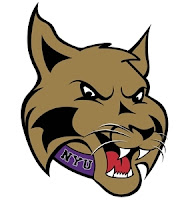Work made for hire cases come up pretty often, but when they do the question usually is whether the person was an employee. This is the question that the factors in Community for Creative Non-Violence v. Reid are used to answer.
But for a work to be a work made for hire, the work must also have been within the scope of the employee’s employment, i.e., that it was the kind of work the employee was employed to perform.
Plaintiff Ariel Fleurimond was a student at NYU and was employed in the work-study program. Her first job was as an equipment room aid for two of the gym facilities and for a brief time had a job as a web designer for the NYU College of Dentistry. She then accepted a job doing graphic design work for the Athletics Department. Her job was initially adding graphics to the department website, creating banners for the gyms, and creating advertisements for the events and the store. She sometimes worked at home and sometimes at school, but got paid for the work either way.
Three weeks after she started the design job for the athletics department, Fleurimond’s supervisor, Isa, asked Fleurimond if she knew how to draw. When the answer was in the affirmative, Isa asked Fleurimond if Fleurimond would be interested in participating in a project to create a new mascot design.
Fleurimond worked on a number of mascot designs, including the “giant cat,” forward facing cat,” “strutting cat,” “happy cat” and “kid cat.” She submitted invoices and was paid for her work sketching and revising these designs.
Then she drew the design in dispute, “Orion”:
 |
| A subsequent version from the copyright registration |
She didn’t submit invoices for this work and claimed that, when she submitted it, she presented it for NYU to consider “outside of the scope of what they were asking [her] for at the time.”
Fleurimond then was asked to include the design in a “Branding Book” so that they could see how the design would look when used for promotional materials.
She submitted invoices for and was paid for this work.
Throughout the process, Fleurimond was claiming that the mascot design was hers, that there were “unauthorized uses” of the mascot, and that she was told she would be compensated for the design. The University disagreed and we have a lawsuit.
So there is no question that Fleurimond was an employee, but was mascot design within the scope of her work? To decide,
| courts look to whether the work: (1) was the kind of work that the plaintiff was employed to perform; (2) occurred substantially within the authorized time and space limits of the job; and (3) was actuated, at least in part by a purpose to serve the employer. |
On the first factor, Fleurimond claims that she was hired to do graphic design work, not drawing, which required “artistic ability,” so the mascot was not the work she was employed to perform. The court didn’t agree; the mascot design required both “artistic” and “technical” skill. Fleurimond was also directed in her work, including directed in changes to be made to the Orion version of the mascot, which meant it was the kind of work she was hired to do.
On the second factor, while Fleurimond indeed worked at home on her own computer most of the time including on the mascot project, her compensation was not tied to where and when she worked. Therefore the work was completed within the authorized time and space limits of the job.
Finally, on the third factor, clearly the task was done to serve the employer; Fleurimond agreed that the design was done at the request of NYU and delivered to NYU with the hope and intention that the University would use it. So, summary judgment that NYU owns the copyright in the logo was granted in favor of NYU.
The whole thing smacks of youthful bad judgment. Fleurimond’s decision not to bill for the design work for this one particular logo design suggests that she was looking for a payday from the start. She then made the naive mistake of thinking that simply not asking to get paid for the work would mean it was hers (if it was only so simple).
Fleurimond would have been so much better off simply asking the University to allow her to claim credit for designing the mascot. That would be quite an accomplishment for a young designer, still in school. Instead, she will now have a reputation as difficult to work with and quick to jump on any perceived wrong, even those of her own doing.
Fleurimond v. New York University, Civ. No. 09-CV-3739 (ADS)(AKT) (E.D.N.Y. July 10, 2012).
Fleurimond affidavit here.
 The text of this work is licensed under a Creative Commons Attribution-No Derivative Works 3.0 United States License.
The text of this work is licensed under a Creative Commons Attribution-No Derivative Works 3.0 United States License.



